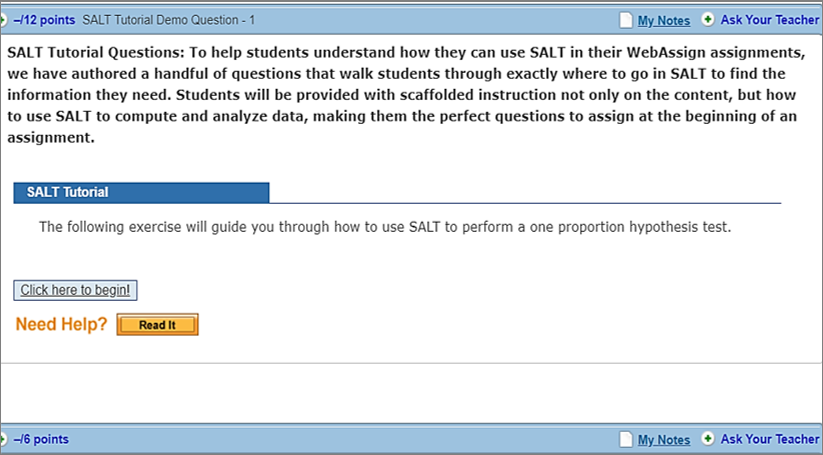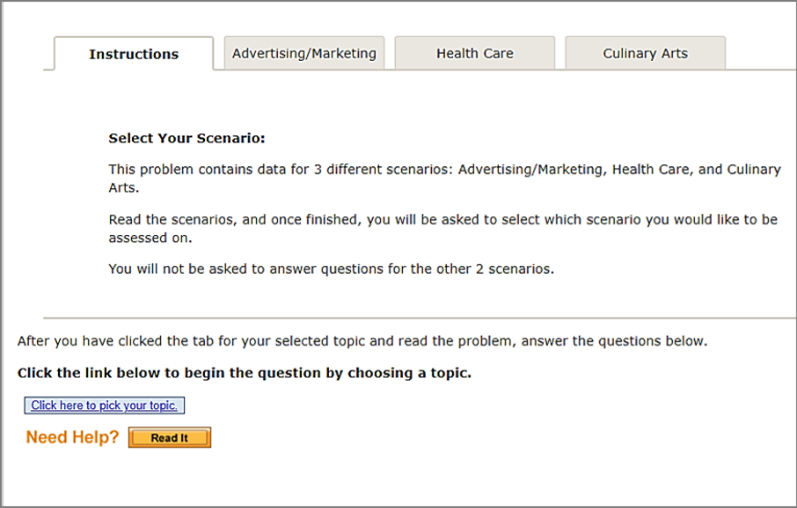The Statistical Analysis and Learning Tool (SALT) is a data analysis tool designed by statisticians. It helps you engage introductory students in data manipulation, analysis and interpretation without bogging them down in complex computations.
SALT has been perfected through extensive partnerships with Statistics educators and in-class testing by both instructors and students. It’s a valuable tool for Statistics instructors to use in and out of WebAssign. Help students understand the meaning behind data and think statistically by applying these six tips for using SALT in your Statistics course.

1. Include SALT Questions in your Assignments
You can easily integrate SALT into your course by utilizing pre-built questions that include an embedded “Use SALT” button. When you select “Use SALT,” WebAssign automatically pulls all of the question data into SALT for students to analyze.
Approximately one third of existing Cengage Statistics questions in WebAssign include SALT automatically, and we will add more over time. You’ll find SALT in questions where the problem involves a statistical function supported by SALT and it involves both computation and interpretive parts.
To find SALT questions in your course, search the “.S” abbreviation in the WebAssign question browser, or ask your Cengage representative for a full list of questions with SALT available for your title.
2. Schedule the Getting Started Assignment During the First Week of Class
Do your students often ask how to use specific features in WebAssign? Assign our pre-built Getting Started assignment, which includes:
- Tips to help students interact with the variety of question types in WebAssign
- Advice for using My Class Insights to study for their exams
- SALT tutorial questions to help students understand the purpose of the data analysis tool within a Statistics course and how it works
To assign the Getting Started Assignment, download it from your Course Packs or search the Assignment ID (16984807) in WebAssign.
3. Assign SALT Tutorial Questions

If you decide not to schedule the Getting Started assignment, make sure your students still know how SALT works. We’ve created questions called SALT Tutorials that walk students through exactly where to go in SALT to find the information they need.
Students will be provided with scaffolded instruction not only on the content, but also on how to use SALT to compute and analyze data, making them the perfect questions to assign at the beginning of an assignment.
You can find SALT Tutorial questions in the Question Browser by searching “.ST”, or by finding the chapter section labeled “SALT Tutorial.”
4. Schedule “Select Your Scenario” Questions
Personalize the student learning experience with Select Your Scenario problems. These questions provide students with three different contexts to choose from and allow students to choose the scenario most relevant to them. Then, the student will solve the problem with support from SALT.
Regardless of which scenario the student chooses, they will answer questions demonstrating knowledge of a learning objective. These are the perfect questions to assign toward the end of a chapter.
You can find Select Your Scenario questions in the Question Browser by searching “.SYS”, or by finding the chapter section labeled “Select Your Scenario.”

5. Use SALT in Class with Your Students
SALT is available in WebAssign questions and can be accessed outside of WebAssign at statistics.cengage.com. Whether you’re teaching an in-person class or teaching online, take a few minutes to show this data analysis tool to your students. Faculty who participated in a Beta program for SALT saw increased student engagement in their courses by doing this.
Additionally, SALT comes pre-loaded with data sets from the Cengage Dataset hub designed to grab students’ interest. Use our data sets or upload your own Excel spreadsheets (CSV format only) and use SALT to show various types of charts and graphs, distribution curves and other Statistics topics with your students.
6. Get SALT Help and Updates
Do you need more help learning how to teach with SALT? Visit the SALT hub where you can find full lists of features, help documentation, getting started materials and frequently asked questions.

